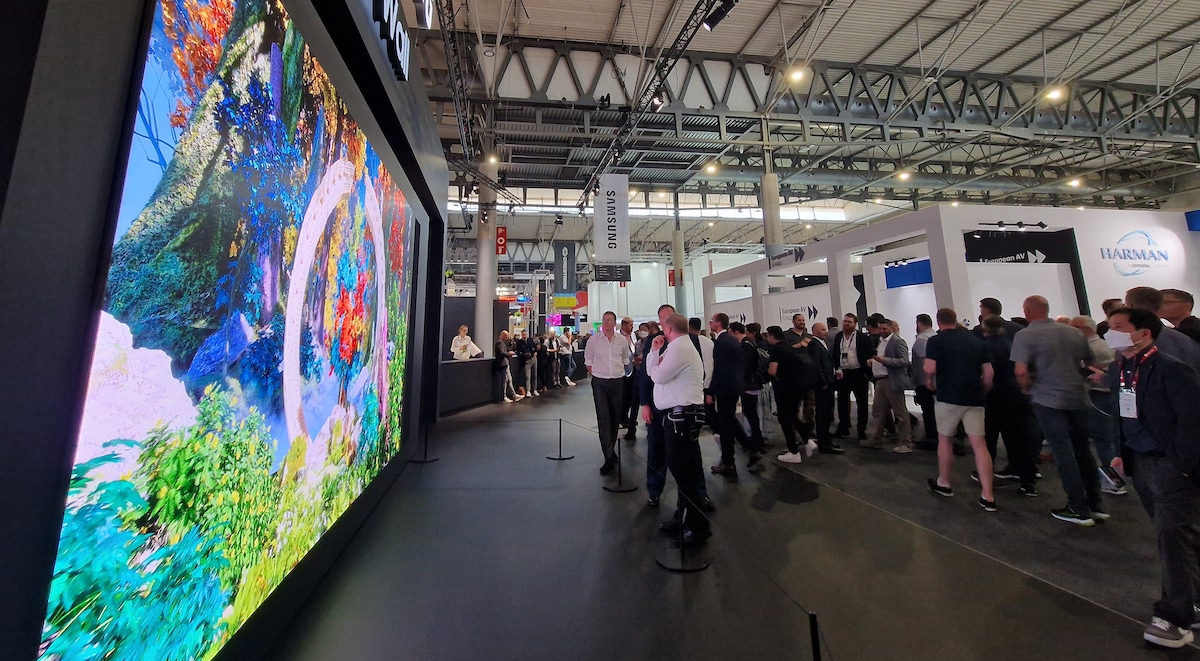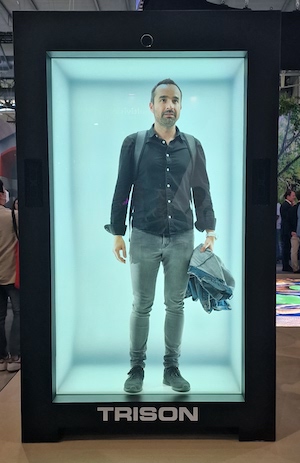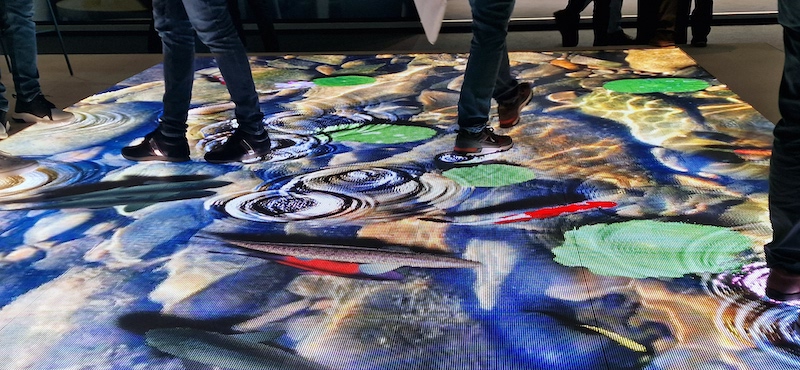
Only Connect: The Digital Signage Industry (And I) Return To ISE
May 12, 2022 by guest author, James Matthews-Paul
Guest Post: James Matthews-Paul, Silver Curve
 Is there anything new under the sun? For ISE, there’s a new location, certainly, in Barcelona, but whether or not this is reflected at the show in technology terms is a point of debate.
Is there anything new under the sun? For ISE, there’s a new location, certainly, in Barcelona, but whether or not this is reflected at the show in technology terms is a point of debate.
Worth is not always priced in novelty or youth, however, a fact that is certainly on my mind as I return to the digital signage trade after five years’ absence with grey hair, a new role and, as we all have, a simple need to do as Evelyn Waugh said and “Only connect.”
Only connecting is the legitimate watch phrase for an industry that, in technology terms, has reached a certain degree of maturity. Coming principally from the print trade as I do – as both a former journalist and publishing entrepreneur, and a commentator on wide-format print tech – the fact that digital signage appears to have hit a technology plateau is relatable. A former colleague used to say that it didn’t matter if the banner had been drawn by kids with crayons; did it function at the viewing distance for the purpose required?
In that sense, from five years ago to now, nothing has really changed. The same technologies have developed and improved. The software is sleeker and more fully functioning; LED refines over ever-shortening generations. What has changed, and what needed to, is application – or how to connect the component elements to create real-life examples.
The stands that stun at ISE are those that set aside sheer tech for how it can be used.
ISE is, and always has been, a hub for geeks. But the companies that have done it best this year are those who put the kit into context. Panasonic, Sony and Christie were always going to have sleek stands and they’re enjoyable for those whose job it is to connect the dots; who can see a bunch of screens and stats and know intrinsically how to put them all together. Yet, as it was for me in print, it’s imperative that we inspire those whose job it is to be imagineers. Who don’t know how to make the magic happen, but do know why they need to make it do so right now for their bosses, for their clients, for an end customer.
And this is where two stands pull it together for me particularly. Hall 3 is twice the length of the others, but walk it properly and you can’t help but feel an affinity for Trison and Samsung.
Of course, people are going to clamour towards the probably million-pound (and certainly very warm) ‘The Wall’ that sits front and centre of the Samsung stand. When I was writing about digital signage from the perspective of the traditional sign and display trade we didn’t give LED much shrift; we saw it as a limited OOH technology. To see 0.8mm pitch at a very short viewing distance, even as a proof of concept, is quite stunning and its futuristic graphics do it no harm, either.
Behind this, pleasingly, sits a bunch of real world examples that pitch Samsung as an end-to-end vendor. With tours every hour on the half-hour, this is definitely a ray of sunshine to lap up. And as someone from the old-style display trade this pleases me; it can’t always be up to Peerless-AV and their ilk to come up with proper real-world applications, such as their outdoor menu boards with modular output formats and the actual promise of two-person installation, and cover the issues overlooked by all but those with real practical experience.

Trison, though, is the stand where adults become kids. Water and fish show off the fluency and accuracy of a screen in such a relatable way anyway, and being able to step on a reactive multi-touch floor screen isn’t particularly new. But when that design concept is backgrounded by two huge curved screens reaching from well above head height to ground level, and preceded by whitescreen trompe l’oiel technology – person in box appears in projection in other box – then one really feels in the presence of magic.
Even the heaviest suits of the trade can’t help but stomp around or film and giggle, Facetime-ing their kids or their spouse, because it reduces us to a ludic child state, and it’s instantly relatable. This is what the technology of this industry should do: to bridge that gap between the fantastic and the feasible, and link us from technical possibility with absurd reality.
Absen’s XR offering, demonstrating how top-flight shows like The Mandalorian are filmed in a post-greenscreen era, allows visitors to place themselves within a physical foreground, a magical backdrop reacting perfectly to a camera that captures around them with seamless TV output. When we can picture ourselves in it, then there’s a channel and it’s this point of maturity within the market’s applications that makes it more relatable to others than before.
Walking the floors – whether or not they are covered with psychedelic fish – is an activity that can’t be replaced by Zoom, although some of the vendors in hall 2 would like you to think it can, and are horrifyingly good at making it near enough a reality.
Between the halls, however, are spaces dedicated to smaller businesses, many of which are unsurprisingly dedicated to teleconferencing. In these spaces treasure can also be found, and unusual solutions to unusual problems. At 4A606 can be found UK outfit Smarter Surfaces, who make paint for projector walls that minimize reflection from side-lighting – typically naturally light from windows – to prioritize front-lit projection.
Out there at a show someone is likely solving a problem you didn’t know about, and no matter what virtual events promise, you may not know that you had it until you’ve discovered that one-square-meter stand.
Coming from the print trade, ISE is a very well thought through event; proper budget and care is given to show features in a way that I’ve not always been used to seeing. I love how the show feels like a collective with something to show and something to say. There are, however, improvements that need to be made to bring the basic show presentation into the modern era.
Specifically for a show that majors on technology use in the public space, the wayfinding is appalling: each company’s locator has a hall, row and stand number, but nowhere are the rows or columns marked. Modern stands in this sector are rarely the cheap old shell schemes of the olden days because the infrastructure simply can’t carry the kit that’s on show. But in turn that means that there are no stand numbers anywhere!
Hall 3 is a particular culprit, so identifying where you are is really a case of picking a landmark and hoping you remember what is on or near or around it. The app, sadly, is of no help whatsoever; zooming in and out on my exceptionally new smartphone was nigh on impossible, and this really needs to be invested in to improve the user experience about which we were all banging on.
Some attendees seemed to enjoy the digital-only badge system, but for old-timers like me, with some snow on the roof and five years out of the game, a physical badge provides reassurance. I was glad to be able to claim one upstairs from the main entrance at a quieter moment on day one. “Oh, Alexeï [Lipov]!” I was able to recall to my favourite PR man of a certain era; I could remember that he lived down the road from me, and has a wife and two kids, but absolutely not the name of the communications consultancy we’d bonded over as he launched it eight years ago. Your mileage may vary, but as a man of print, I have to say that it has its purposes.
Connecting the different parts of this fast-paced and ever-moving technology are crucial to the trade. Now I’ve taken the dark dollar and become not only a salesperson, but also second-in-command to the quickest problem-solver in digital signage, I realize that ‘only connect’ has more than only the human or technical meanings in this context. It is a visceral need that hangs modern society together and visual technologies are prevalent as we reimagine what that might be.
We can have tech, and we can have people, but how we bring them together is paramount. This is what trade shows do, and what ISE does particularly well – but also what this edition of ISE does especially. Go, and if nothing else, only connect.
About The Writer
James Matthews-Paul is Director of Client Services for Silver Curve, a London-based technology consultancy focused on digital signage. He will be well-known in pro AV circles as the Editor In Chief of the late, great Output Magazine.



Good to have you back, James. I have always enjoyed the pictures you paint with your words in your inimitable style.
Having not made the trip to Barcelona this year, I have relied on Linkedin posts and press releases to be there ‘virtually’.
However, without a doubt, your article has conjured up the most vivid and resonant mental images.
Hi James, I was thinking the same about the missing booth number and the digital only badges, you have to carry your traditional business card to say who you are and connect more easily to everyone. The digital-only isn’t the easy way for everything, even in the digital heaven!